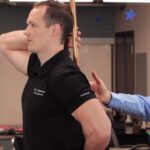Hip Hinge Technique | Early Intervention Ergonomics
What is the Hip Hinge Technique?
The Hip Hinge Technique targets the hamstrings, glutes, and lower back. By incorporating this stretch into your routine, you can improve flexibility, mobility, and stability in the hip joint. Follow these steps to perform the Hip Hinge technique with a stick:
- Stand tall with feet shoulder-width apart, holding a stick against your back.
- Initiate the movement by hinging forward at the hips while maintaining a straight back and stick contact.
- Continue hinging until you feel a gentle stretch in your hamstrings.
- Hold the position briefly, focusing on core engagement and proper alignment.
- Return to the starting position by engaging your glutes and driving your hips forward.
Incorporating the Hip Hinge stretch with a stick can contribute to your overall fitness and flexibility goals. Remember to prioritize proper form and listen to your body’s limits. If you experience any discomfort, it’s advisable to consult a fitness professional or healthcare provider.
The video above illustrates a technique of maintaining a neutral spine when lifting an object from the floor.
Early Intervention Benefits
The hip hinge stretch with a stick offers numerous early intervention benefits for individuals looking to improve their flexibility, mobility, and overall fitness. Incorporating this exercise into your routine can provide the following advantages:
- Increased flexibility: The hip hinge stretch targets the hamstrings, glutes, and lower back, helping to enhance the flexibility of these muscle groups. Improved flexibility can lead to better athletic performance and reduced risk of injuries.
- Enhanced hip mobility: This stretch specifically focuses on the hip joint, promoting increased range of motion and mobility. Better hip mobility is crucial for activities like squatting, running, and performing various lower body movements.
- Improved posture and spinal alignment: By maintaining a straight back and proper alignment during the hip hinge stretch, you can improve your posture and spinal alignment. This can alleviate tension in the lower back and contribute to better overall posture.
- Core stabilization: The hip hinge stretch requires engaging the core muscles to maintain stability and proper form. Regular practice of this exercise can help strengthen the core, leading to improved stability and balance in daily activities and workouts.
- Injury prevention: By improving flexibility, mobility, and core stability, the hip hinge stretch with a stick can help reduce the risk of injuries, particularly in the lower back, hips, and hamstrings. It can also help alleviate tightness and imbalances in these areas, which are common contributors to injuries.
These exercises are to improve overall health & fitness as well as reduce work-related injuries.
If you have an injury or illness, consult with a health care professional before attempting. Contact us for more information on how we can help your employees stay safe.
More Tools & Resources from Peak Ergonomics
Contact Us About Reducing Workplace Injuries
Healthy Employees are the Bottom Line! – Learn More!

